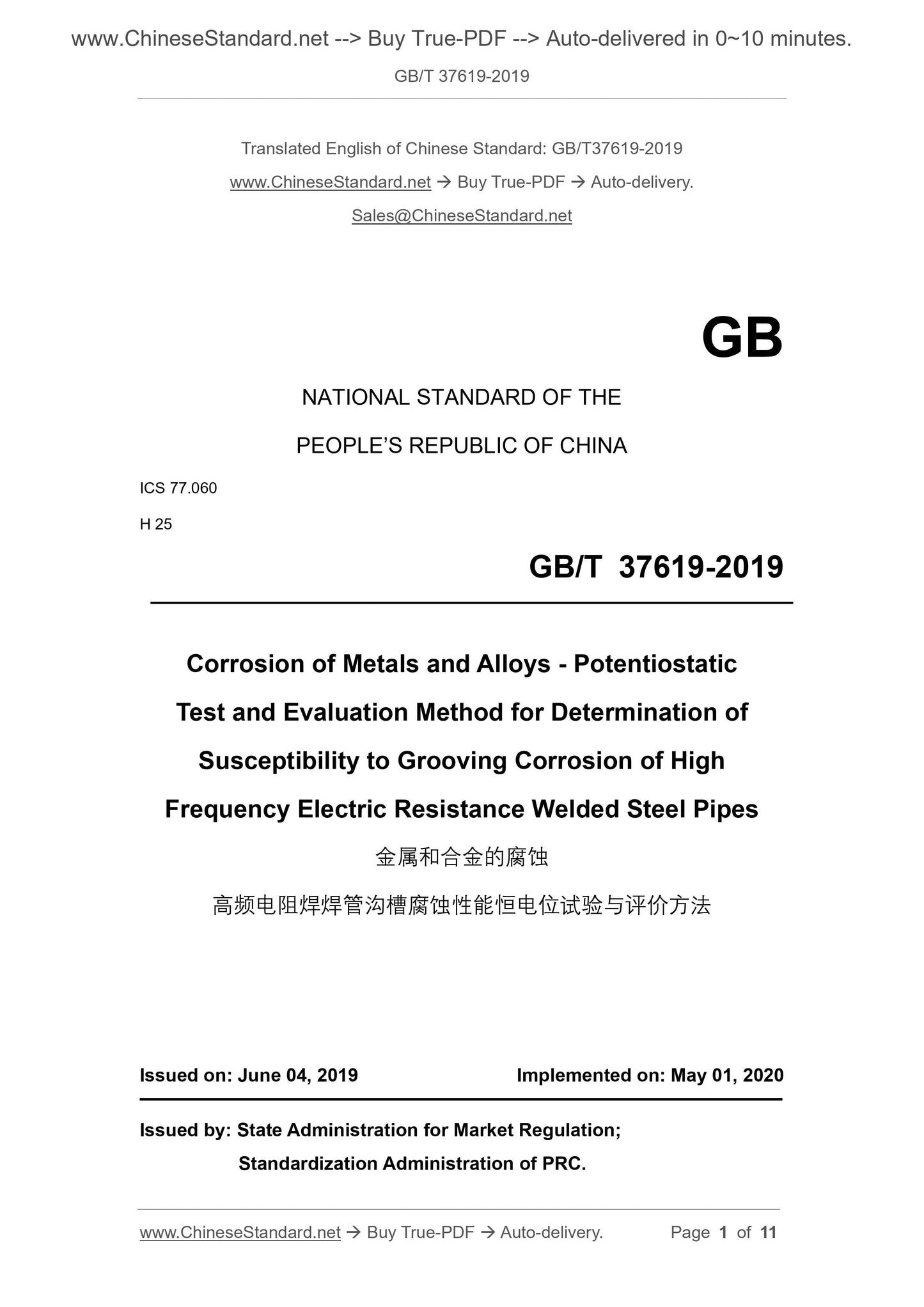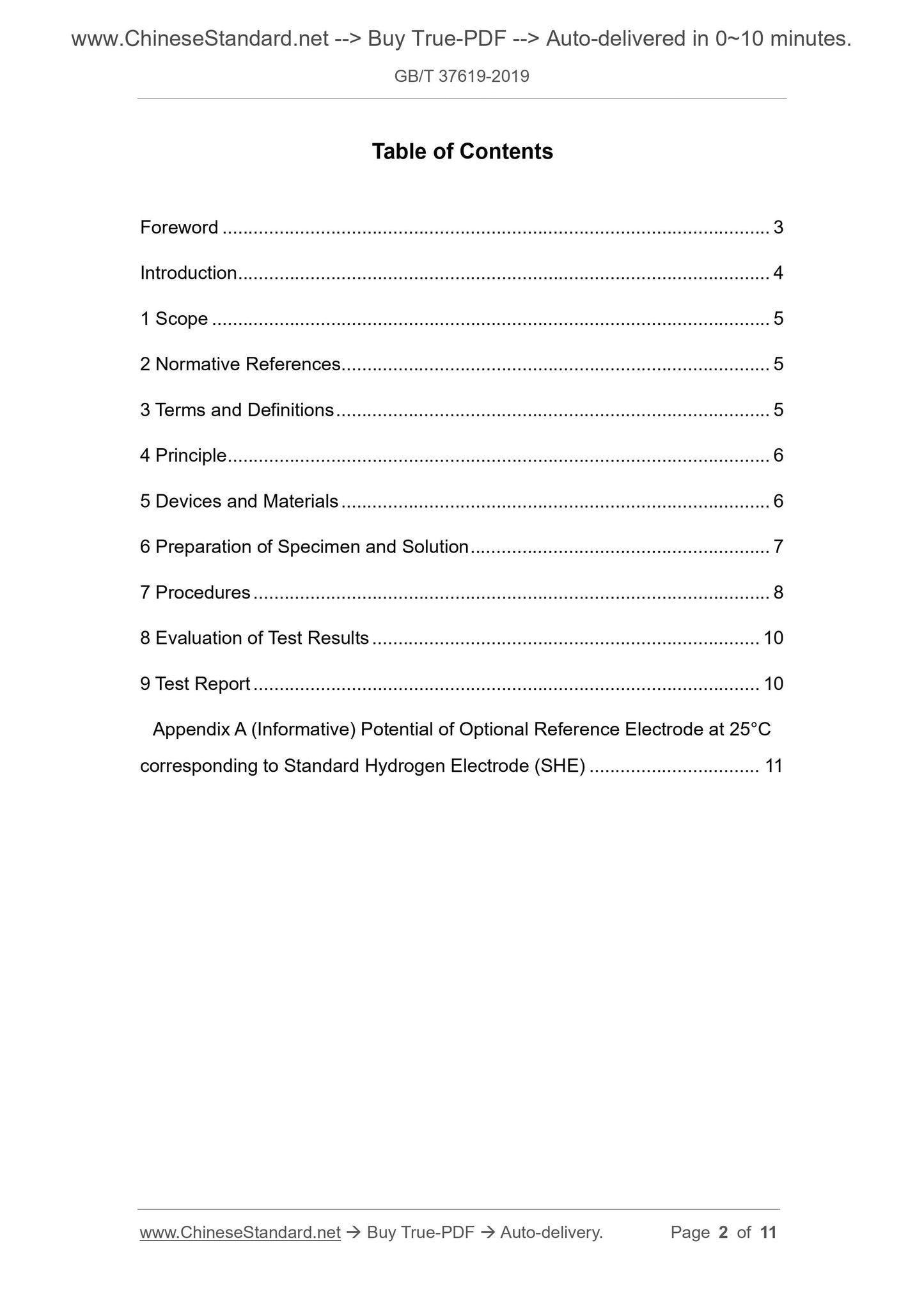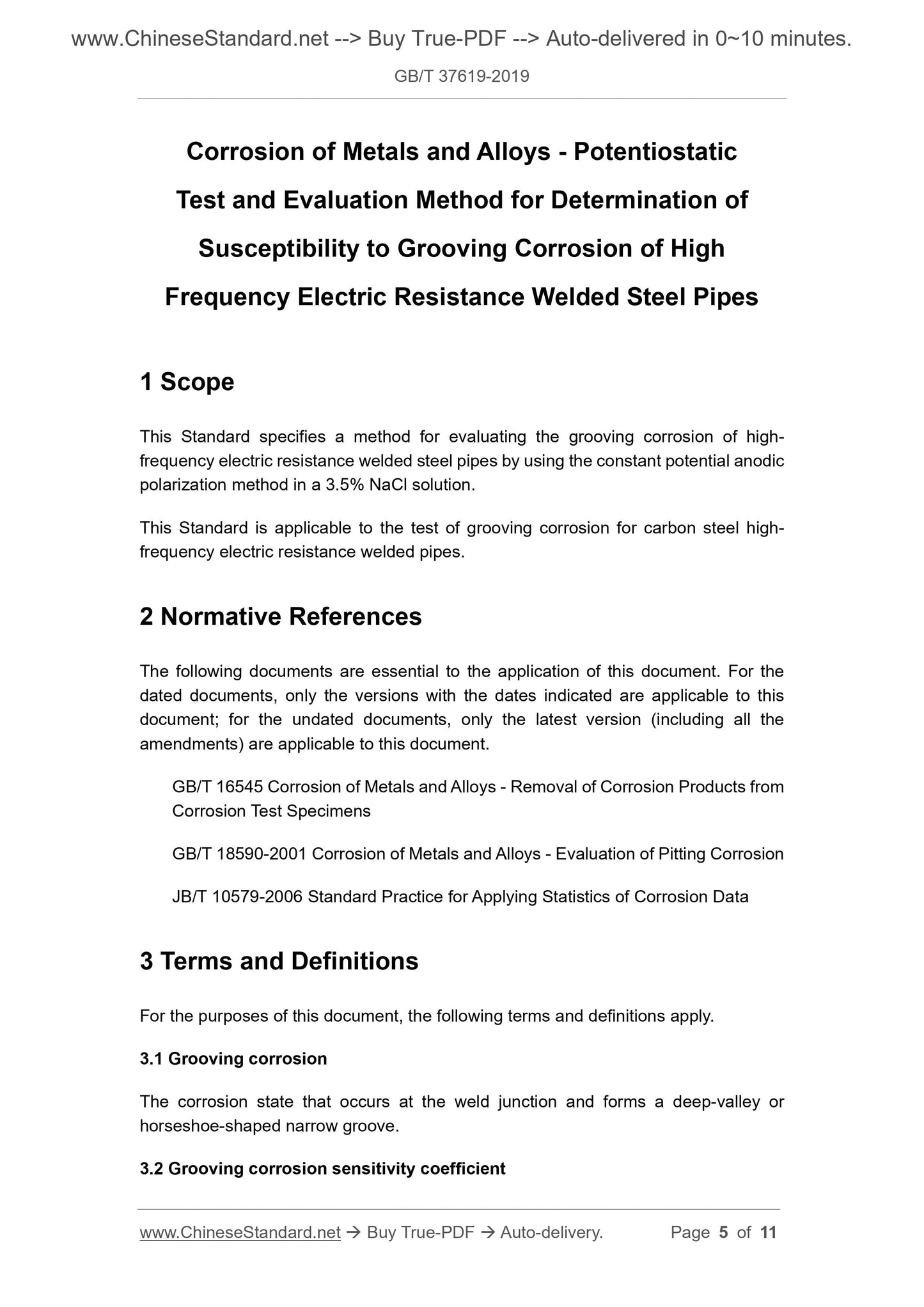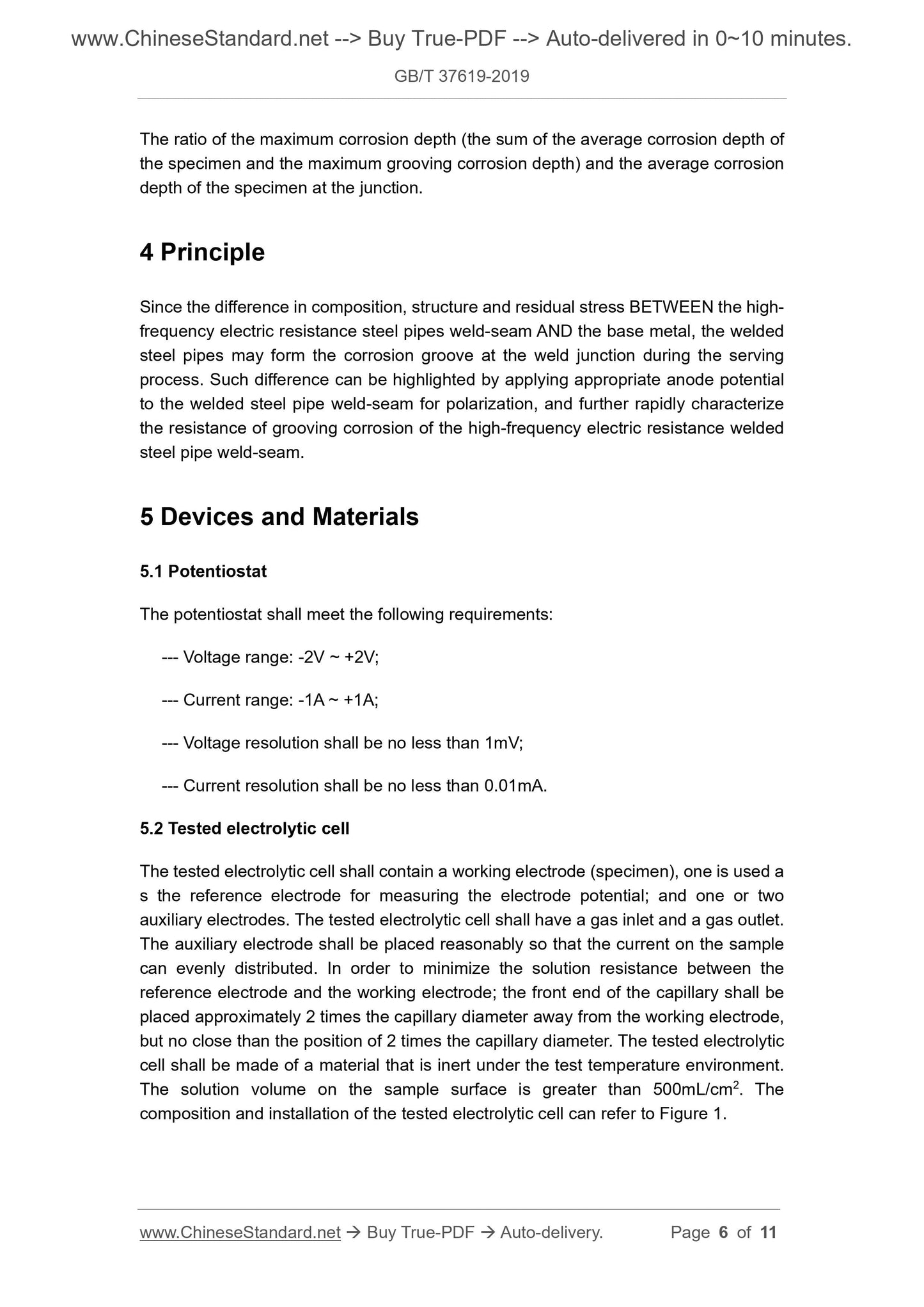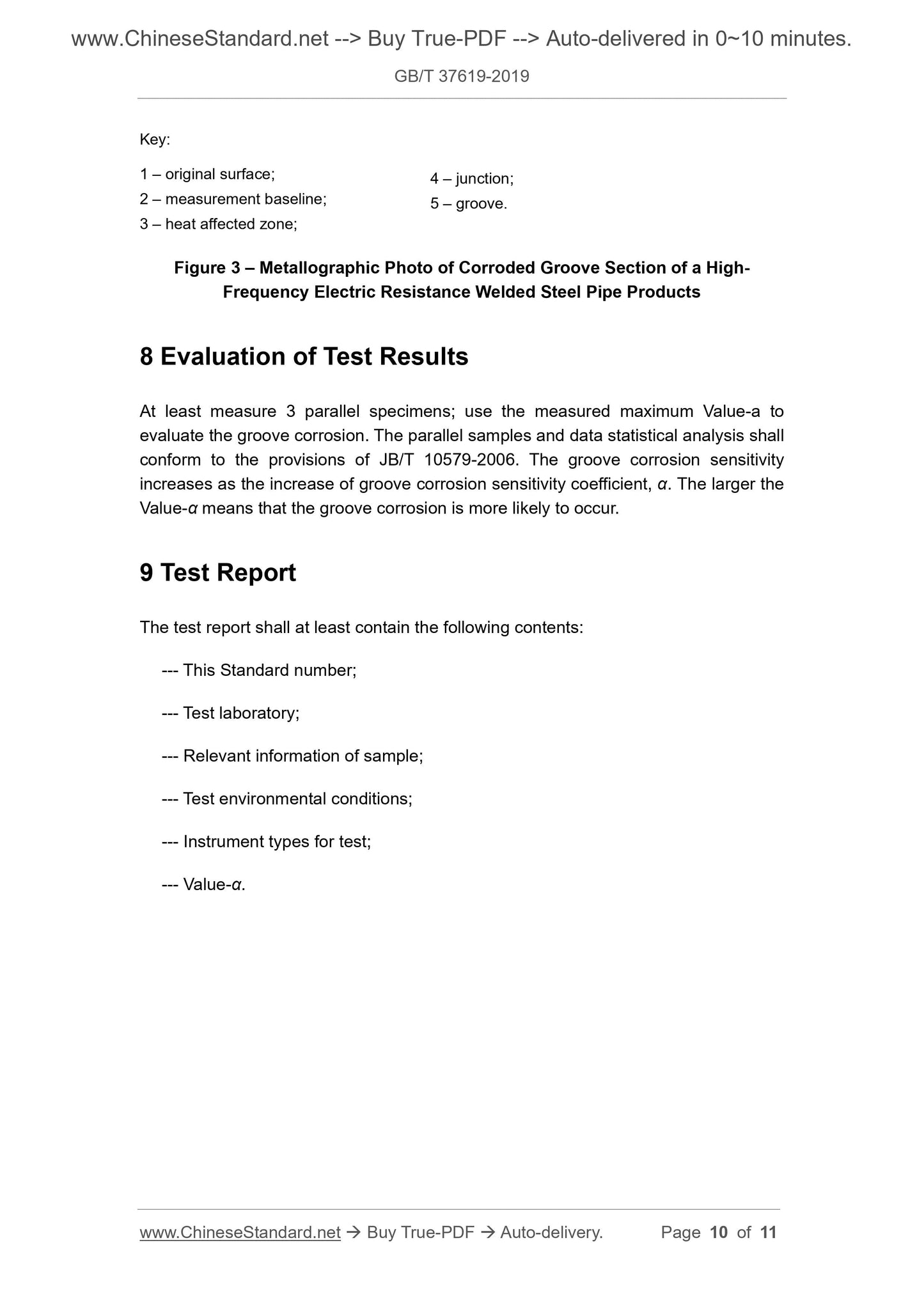1
/
de
5
PayPal, credit cards. Download editable-PDF & invoice in 1 second!
GB/T 37619-2019 English PDF (GBT37619-2019)
GB/T 37619-2019 English PDF (GBT37619-2019)
Prix habituel
$150.00 USD
Prix habituel
Prix promotionnel
$150.00 USD
Prix unitaire
/
par
Frais d'expédition calculés à l'étape de paiement.
Impossible de charger la disponibilité du service de retrait
Delivery: 3 seconds. Download true-PDF + Invoice.
Get QUOTATION in 1-minute: Click GB/T 37619-2019
Historical versions: GB/T 37619-2019
Preview True-PDF (Reload/Scroll if blank)
GB/T 37619-2019: Corrosion of metals and alloys -- Potentiostatic test and evaluation method for determination of susceptibility to grooving corrosion of high frequency electric resistance welded steel pipes
GB/T 37619-2019
NATIONAL STANDARD OF THE
PEOPLE’S REPUBLIC OF CHINA
ICS 77.060
H 25
Corrosion of Metals and Alloys - Potentiostatic
Test and Evaluation Method for Determination of
Susceptibility to Grooving Corrosion of High
Frequency Electric Resistance Welded Steel Pipes
ISSUED ON: JUNE 04, 2019
IMPLEMENTED ON: MAY 01, 2020
Issued by: State Administration for Market Regulation;
Standardization Administration of PRC.
Table of Contents
Foreword ... 3
Introduction ... 4
1 Scope ... 5
2 Normative References ... 5
3 Terms and Definitions ... 5
4 Principle ... 6
5 Devices and Materials ... 6
6 Preparation of Specimen and Solution ... 7
7 Procedures ... 8
8 Evaluation of Test Results ... 10
9 Test Report ... 10
Appendix A (Informative) Potential of Optional Reference Electrode at 25°C
corresponding to Standard Hydrogen Electrode (SHE) ... 11
Corrosion of Metals and Alloys - Potentiostatic
Test and Evaluation Method for Determination of
Susceptibility to Grooving Corrosion of High
Frequency Electric Resistance Welded Steel Pipes
1 Scope
This Standard specifies a method for evaluating the grooving corrosion of high-
frequency electric resistance welded steel pipes by using the constant potential anodic
polarization method in a 3.5% NaCl solution.
This Standard is applicable to the test of grooving corrosion for carbon steel high-
frequency electric resistance welded pipes.
2 Normative References
The following documents are essential to the application of this document. For the
dated documents, only the versions with the dates indicated are applicable to this
document; for the undated documents, only the latest version (including all the
amendments) are applicable to this document.
GB/T 16545 Corrosion of Metals and Alloys - Removal of Corrosion Products from
Corrosion Test Specimens
GB/T 18590-2001 Corrosion of Metals and Alloys - Evaluation of Pitting Corrosion
JB/T 10579-2006 Standard Practice for Applying Statistics of Corrosion Data
3 Terms and Definitions
For the purposes of this document, the following terms and definitions apply.
3.1 Grooving corrosion
The corrosion state that occurs at the weld junction and forms a deep-valley or
horseshoe-shaped narrow groove.
3.2 Grooving corrosion sensitivity coefficient
The ratio of the maximum corrosion depth (the sum of the average corrosion depth of
the specimen and the maximum grooving corrosion depth) and the average corrosion
depth of the specimen at the junction.
4 Principle
Since the difference in composition, structure and residual stress BETWEEN the high-
frequency electric resistance steel pipes weld-seam AND the base metal, the welded
steel pipes may form the corrosion groove at the weld junction during the serving
process. Such difference can be highlighted by applying appropriate anode potential
to the welded steel pipe weld-seam for polarization, and further rapidly characterize
the resistance of grooving corrosion of the high-frequency electric resistance welded
steel pipe weld-seam.
5 Devices and Materials
5.1 Potentiostat
The potentiostat shall meet the following requirements:
--- Voltage range: -2V ~ +2V;
--- Current range: -1A ~ +1A;
--- Voltage resolution shall be no less than 1mV;
--- Current resolution shall be no less than 0.01mA.
5.2 Tested electrolytic cell
The tested electrolytic cell shall contain a working electrode (specimen), one is used a
s the reference electrode for measuring the electrode potential; and one or two
auxiliary electrodes. The tested electrolytic cell shall have a gas inlet and a gas outlet.
The auxiliary electrode shall be placed reasonably so that the current on the sample
can evenly distributed. In order to minimize the solution resistance between the
reference electrode and the working electrode; the front end of the capillary shall be
placed approximately 2 times the capillary diameter away from the working electrode,
but no close than the position of 2 times the capillary diameter. The tested electrolytic
cell shall be made of a material that is inert under the test temperature environment.
The solution volume on the sample surface is greater than 500mL/cm2. The
composition and installation of the tested electrolytic cell can refer to Figure 1.
Key:
Figure 3 – Metallographic Photo of Corroded Groove Section of a High-
Frequency Electric Resistance Welded Steel Pipe Products
8 Evaluation of Test Results
At least measure 3 parallel specimens; use the measured maximum Value-a to
evaluate the groove corrosion. The parallel samples and data statistical analysis shall
conform to the provisions of JB/T 10579-2006. The groove corrosion sensitivity
increases as the increase of groove corrosion sensitivity coefficient, α. The larger the
Value-α means that the groove corrosion is more likely to occur.
9 Test Report
The test report shall at least contain the following contents:
--- This Standard number;
--- Test laboratory;
--- Relevant information of sample;
--- Test environmental conditions;
--- Instrument types for test;
--- Value-α.
1 – original surface;
2 – measurement baseline;
3 – heat affected zone;
4 – junction;
5 – groove.
Get QUOTATION in 1-minute: Click GB/T 37619-2019
Historical versions: GB/T 37619-2019
Preview True-PDF (Reload/Scroll if blank)
GB/T 37619-2019: Corrosion of metals and alloys -- Potentiostatic test and evaluation method for determination of susceptibility to grooving corrosion of high frequency electric resistance welded steel pipes
GB/T 37619-2019
NATIONAL STANDARD OF THE
PEOPLE’S REPUBLIC OF CHINA
ICS 77.060
H 25
Corrosion of Metals and Alloys - Potentiostatic
Test and Evaluation Method for Determination of
Susceptibility to Grooving Corrosion of High
Frequency Electric Resistance Welded Steel Pipes
ISSUED ON: JUNE 04, 2019
IMPLEMENTED ON: MAY 01, 2020
Issued by: State Administration for Market Regulation;
Standardization Administration of PRC.
Table of Contents
Foreword ... 3
Introduction ... 4
1 Scope ... 5
2 Normative References ... 5
3 Terms and Definitions ... 5
4 Principle ... 6
5 Devices and Materials ... 6
6 Preparation of Specimen and Solution ... 7
7 Procedures ... 8
8 Evaluation of Test Results ... 10
9 Test Report ... 10
Appendix A (Informative) Potential of Optional Reference Electrode at 25°C
corresponding to Standard Hydrogen Electrode (SHE) ... 11
Corrosion of Metals and Alloys - Potentiostatic
Test and Evaluation Method for Determination of
Susceptibility to Grooving Corrosion of High
Frequency Electric Resistance Welded Steel Pipes
1 Scope
This Standard specifies a method for evaluating the grooving corrosion of high-
frequency electric resistance welded steel pipes by using the constant potential anodic
polarization method in a 3.5% NaCl solution.
This Standard is applicable to the test of grooving corrosion for carbon steel high-
frequency electric resistance welded pipes.
2 Normative References
The following documents are essential to the application of this document. For the
dated documents, only the versions with the dates indicated are applicable to this
document; for the undated documents, only the latest version (including all the
amendments) are applicable to this document.
GB/T 16545 Corrosion of Metals and Alloys - Removal of Corrosion Products from
Corrosion Test Specimens
GB/T 18590-2001 Corrosion of Metals and Alloys - Evaluation of Pitting Corrosion
JB/T 10579-2006 Standard Practice for Applying Statistics of Corrosion Data
3 Terms and Definitions
For the purposes of this document, the following terms and definitions apply.
3.1 Grooving corrosion
The corrosion state that occurs at the weld junction and forms a deep-valley or
horseshoe-shaped narrow groove.
3.2 Grooving corrosion sensitivity coefficient
The ratio of the maximum corrosion depth (the sum of the average corrosion depth of
the specimen and the maximum grooving corrosion depth) and the average corrosion
depth of the specimen at the junction.
4 Principle
Since the difference in composition, structure and residual stress BETWEEN the high-
frequency electric resistance steel pipes weld-seam AND the base metal, the welded
steel pipes may form the corrosion groove at the weld junction during the serving
process. Such difference can be highlighted by applying appropriate anode potential
to the welded steel pipe weld-seam for polarization, and further rapidly characterize
the resistance of grooving corrosion of the high-frequency electric resistance welded
steel pipe weld-seam.
5 Devices and Materials
5.1 Potentiostat
The potentiostat shall meet the following requirements:
--- Voltage range: -2V ~ +2V;
--- Current range: -1A ~ +1A;
--- Voltage resolution shall be no less than 1mV;
--- Current resolution shall be no less than 0.01mA.
5.2 Tested electrolytic cell
The tested electrolytic cell shall contain a working electrode (specimen), one is used a
s the reference electrode for measuring the electrode potential; and one or two
auxiliary electrodes. The tested electrolytic cell shall have a gas inlet and a gas outlet.
The auxiliary electrode shall be placed reasonably so that the current on the sample
can evenly distributed. In order to minimize the solution resistance between the
reference electrode and the working electrode; the front end of the capillary shall be
placed approximately 2 times the capillary diameter away from the working electrode,
but no close than the position of 2 times the capillary diameter. The tested electrolytic
cell shall be made of a material that is inert under the test temperature environment.
The solution volume on the sample surface is greater than 500mL/cm2. The
composition and installation of the tested electrolytic cell can refer to Figure 1.
Key:
Figure 3 – Metallographic Photo of Corroded Groove Section of a High-
Frequency Electric Resistance Welded Steel Pipe Products
8 Evaluation of Test Results
At least measure 3 parallel specimens; use the measured maximum Value-a to
evaluate the groove corrosion. The parallel samples and data statistical analysis shall
conform to the provisions of JB/T 10579-2006. The groove corrosion sensitivity
increases as the increase of groove corrosion sensitivity coefficient, α. The larger the
Value-α means that the groove corrosion is more likely to occur.
9 Test Report
The test report shall at least contain the following contents:
--- This Standard number;
--- Test laboratory;
--- Relevant information of sample;
--- Test environmental conditions;
--- Instrument types for test;
--- Value-α.
1 – original surface;
2 – measurement baseline;
3 – heat affected zone;
4 – junction;
5 – groove.
Share
